Paris, BnF, lat. 2923
A book of models for writing letters1
This manuscript from the late thirteenth century2 was composed to provide instructions and models for letter-writing. It offers examples of epistolary composition, such as the letters exchanged between Abelard (1079- 1142) and Heloise (d. 1164) and those of magister Stephen of Tournai (1128-1203). The manuscript also contains two anonymous artes dictandi, with precepts on the composition of letters. The manuscript was in the possession of the scholar and poet Francesco Petrarca (1304-1374), who added notes to the letters and used the flyleaves at the end of the codex as a diary.
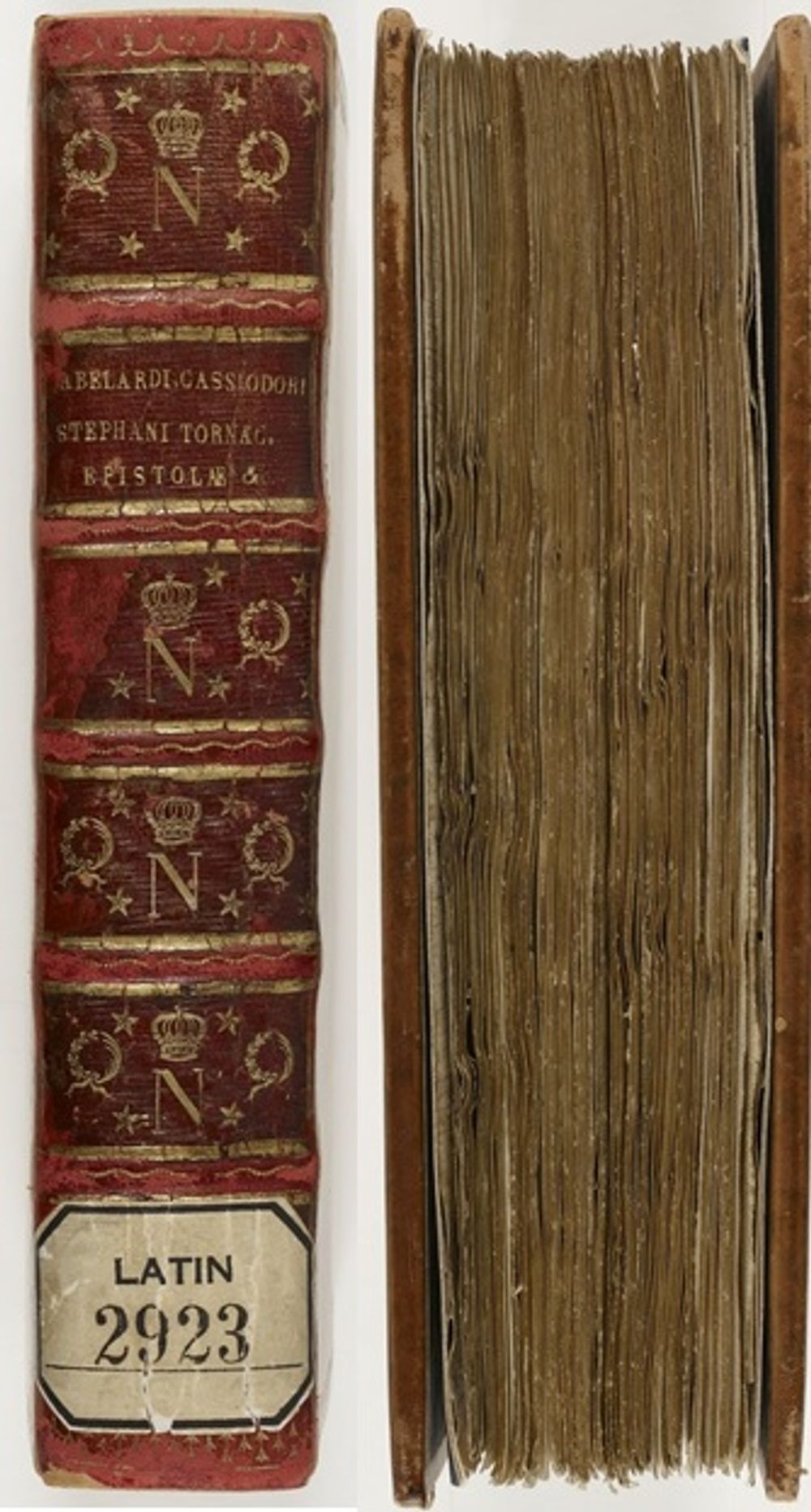
https://gallica.bnf.fr/ark:/12148/btv1b84386206
A sixteenth-century hand wrote a table of contents on a flyleaf (Iv), listing some but not all of the letters in this codex. Highlighted are the letters of Abelard, here called ‘brother Abelard’. The name of his correspondent, Heloise, whose letters make up half of the collection, is not mentioned. The table also lists a letter of Abelard’s staunch defender Berengar of Poitiers (d. c. 1120), the letters of the Roman statesman Cassiodorus (c. 485 – c. 585) and the letters of magister Stephan. Stephen of Tournai (1128-1203) was master of Saint-Geneviève in Paris, where Abelard had also taught. Petrarch may have acquired this codex via his acquaintance, Roberto de Bardi, chancellor of the University of Paris.
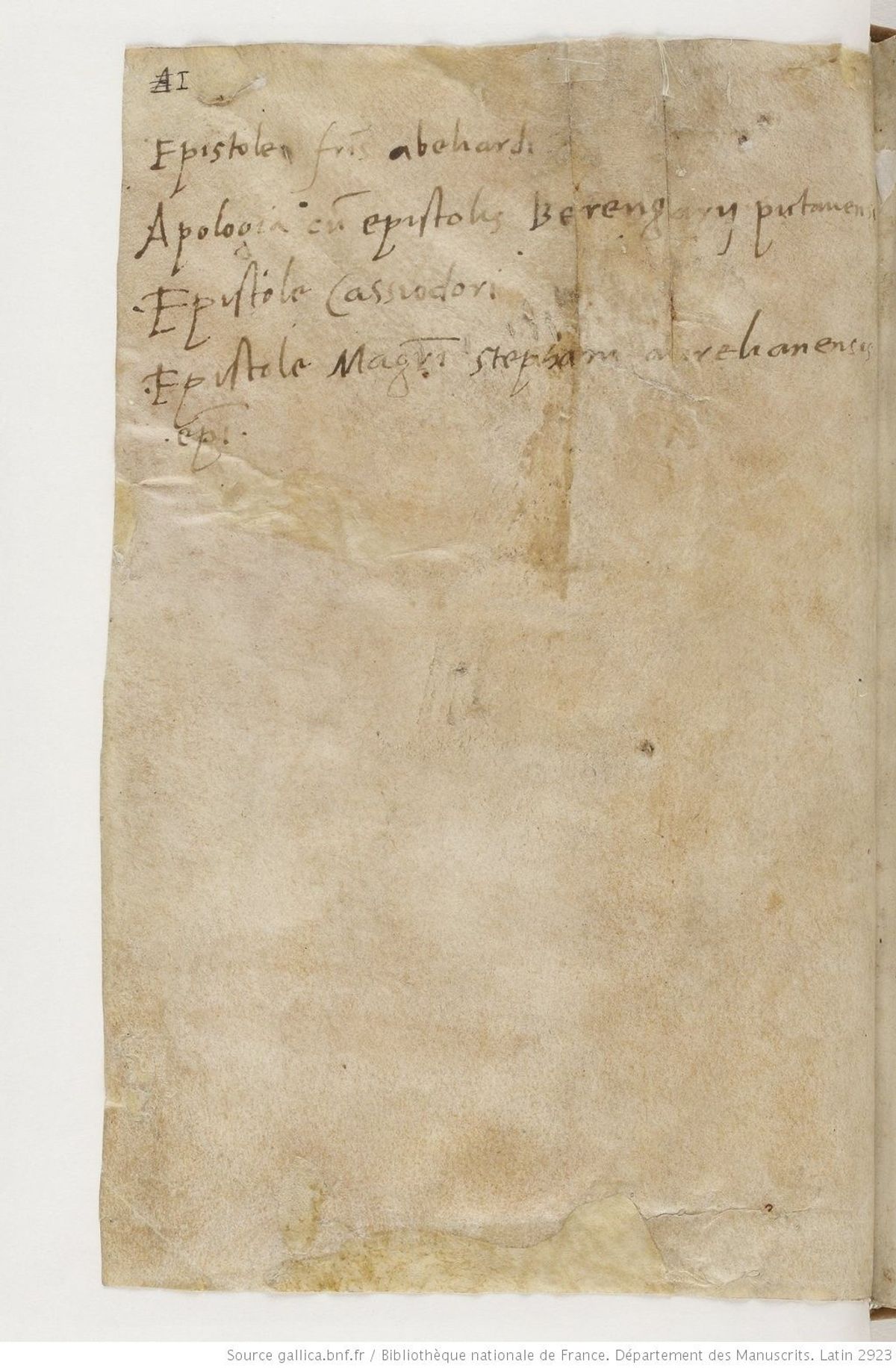

Flyleaves IIv to IVv contain notes on the letters of Abelard, Berengar of Poitiers, Cassiodorus and Stephen of Tournai. A seventeenth-century hand points out that these notes are believed to have been written by Petrarch: “Putantur h(a)ec scripta manu D. F. PETRARCHAE”


Already earlier, a fourteenth-century hand had pointed out that this manuscript once belonged to Petrarch: ‘”d. Francisci Petrarce fuit”; “This belonged to Dom Franciscus Petrarca”. Another note has been erased, and the word “fuit” has been added (anew?) above and partly on top of the erasure.


The first item in the manuscript is the correspondence between Abelard and Heloise, starting with Abelard’s epistolary autobiography, the Historia calamitatum - The Story of My Misfortunes, in which he recounted the story of his love affair with Heloise. A historized initial S opens the autobiography, showing two seated figures holding books. The figure on the left is believed to represent Abelard, the figure on the right Heloise, whose face has been rubbed away.
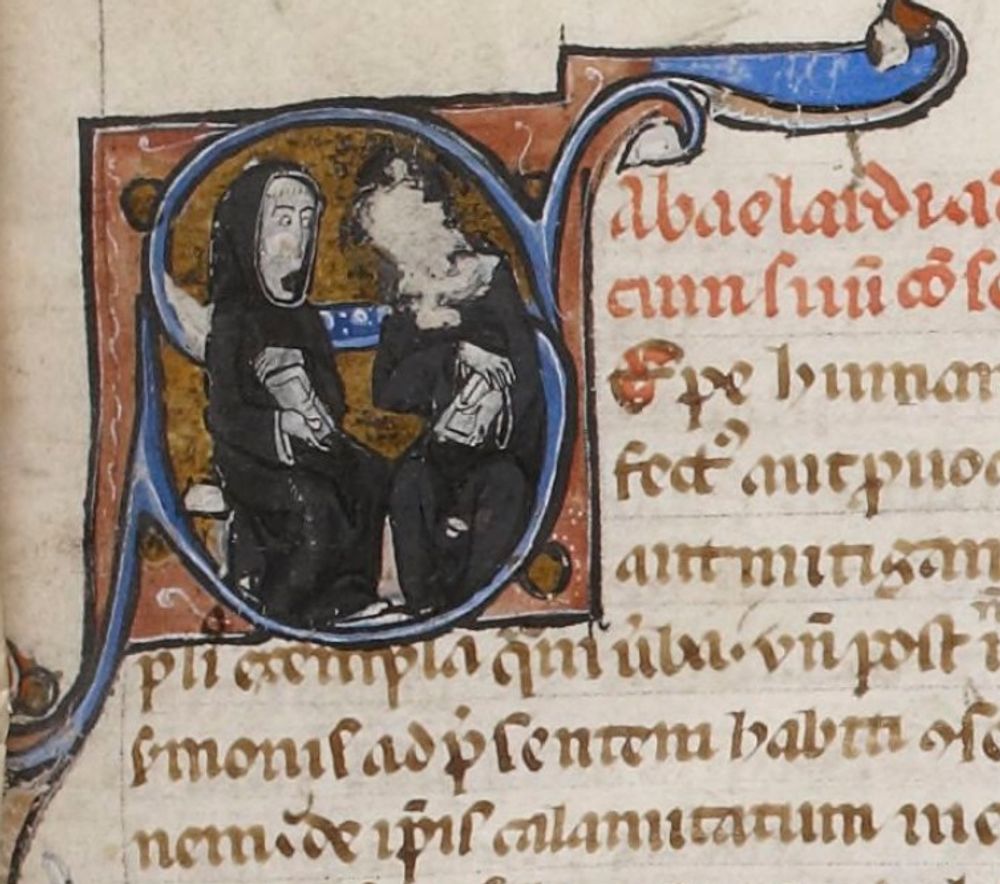
https://gallica.bnf.fr/ark:/12148/btv1b84386206
Following the correspondence of Abelard and Heloise we find the Apologia of Abelard’s student Berengarius of Poitiers. In 1141 the council of Sens had condemned Abelard for heresy, at the instigation of Bernardus of Clairvaux, who objected to Abelard’s philosophical analysis of the Trinity and his rational approach to matters of faith. Berengarius wrote a letter, the Apologia, in which he defended his former master. Berengarius’ Apologia also contains the statement of faith, which Abelard addressed to Heloise (Confessio ad Heloisam) to profess his orthodox beliefs.
This initial S shows Berengar seated on a bench. The annotation above the rubric briefly explains the context of the council of Sens to situate Berengar’s Apologia.
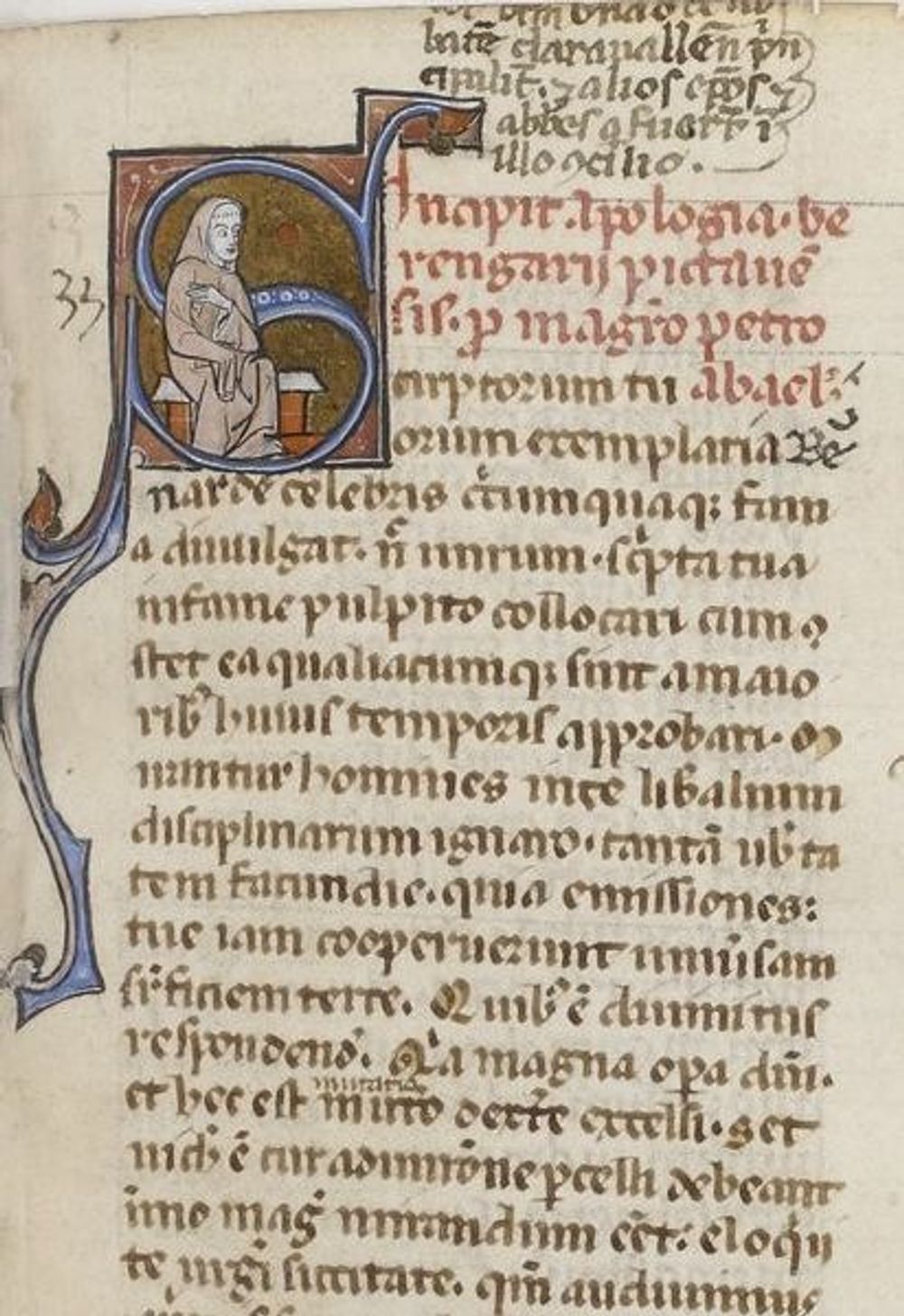
https://gallica.bnf.fr/ark:/12148/btv1b84386206
Two more letter collections follow: the letters of the Roman statesman Cassiodorus Senator (c. 485 – c. 585), written on behalf of the Ostrogothic king Theoderic and those of magister Stephen of Tournai (1128-1203). The initial C on folio 51 recto shows Cassiodorus sitting with crossed legs – the posture of an aristocrat. On folio 94 recto we find, in the initial D, magister Stephen dressed in monastic garb.


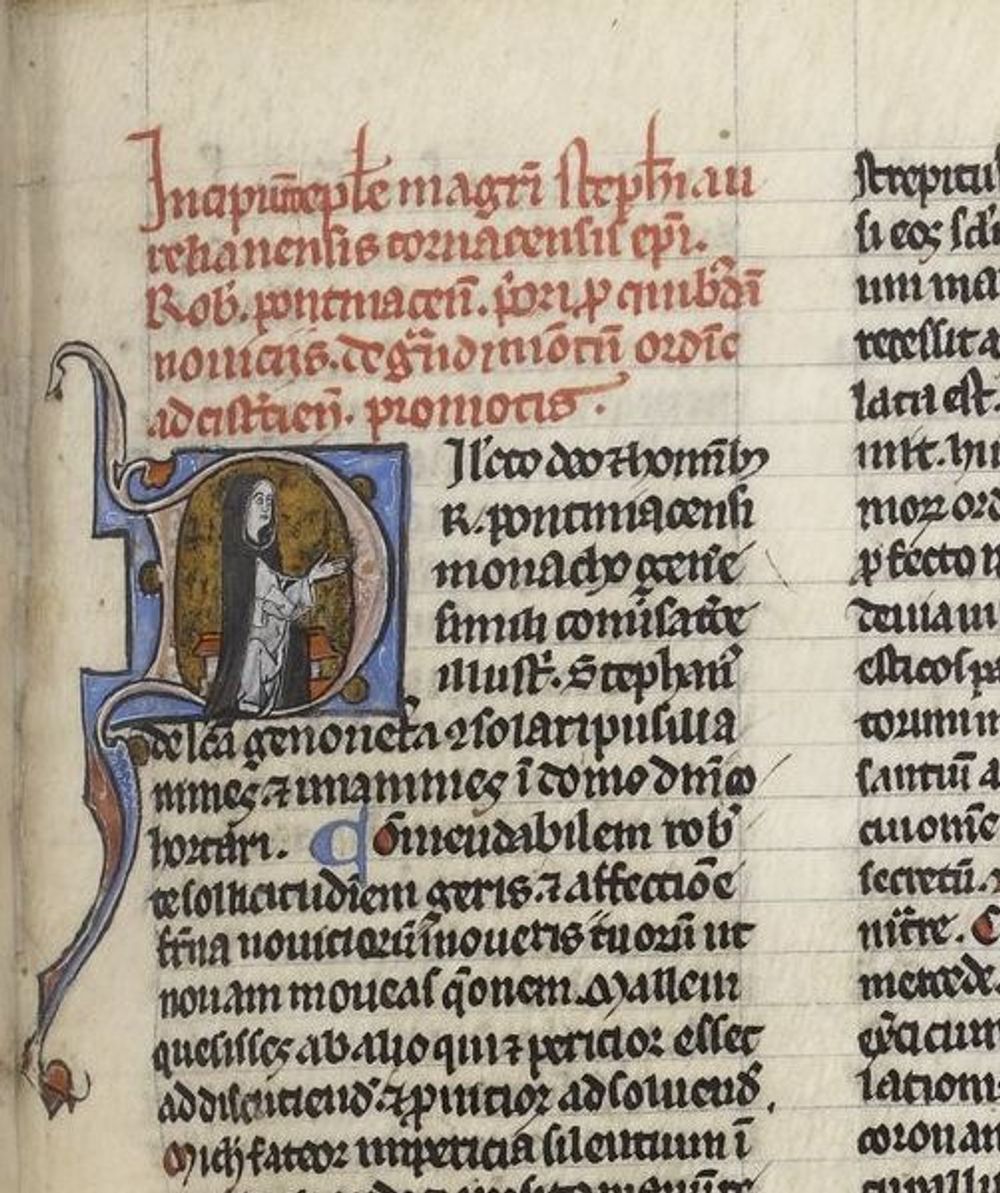

https://gallica.bnf.fr/ark:/12148/btv1b84386206
https://gallica.bnf.fr/ark:/12148/btv1b84386206
Wedged between the letters of Cassiodorus and Stephen are two short anonymous artes dictandi. Here we see a detail of the second treatise on the composition of letters. The unidentified author emphasized the importance of logic to formulate one’s thoughts cogently, persuasively and elegantly.3 At the end of the codex is a formulary (ff. 172-177v ) providing more examples of good Latin style. The examples are taken from letters written by students from different schools in Paris.4
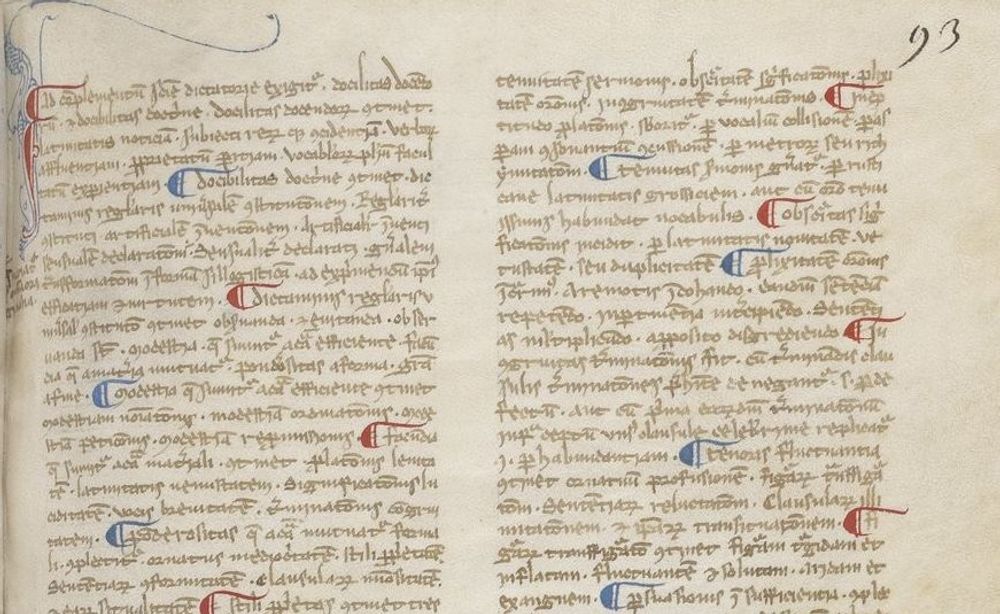
https://gallica.bnf.fr/ark:/12148/btv1b84386206
Francesco Petrarca acquired the codex after 1337, probably when he visited Paris and met up with Robert de Bardi, chancellor of the University of Paris. Petrarch added notes, dots and pointing hands throughout the manuscript. He was particularly interested in the letters of Abelard and Heloise, whose letters received the most extensive comments by his hand.
Petrarch added appreciative remarks on their style of writing. On f. 16r, next to Heloise’s first letter to Abelard, he wrote: “Amicissime et eleganter” — “Most lovingly and elegant”.
A few lines below we see a sign resembling a flower, consisting of four dots with a flourish. This was one of Petrarch’s favourite signs to mark a passage worthy of note.5
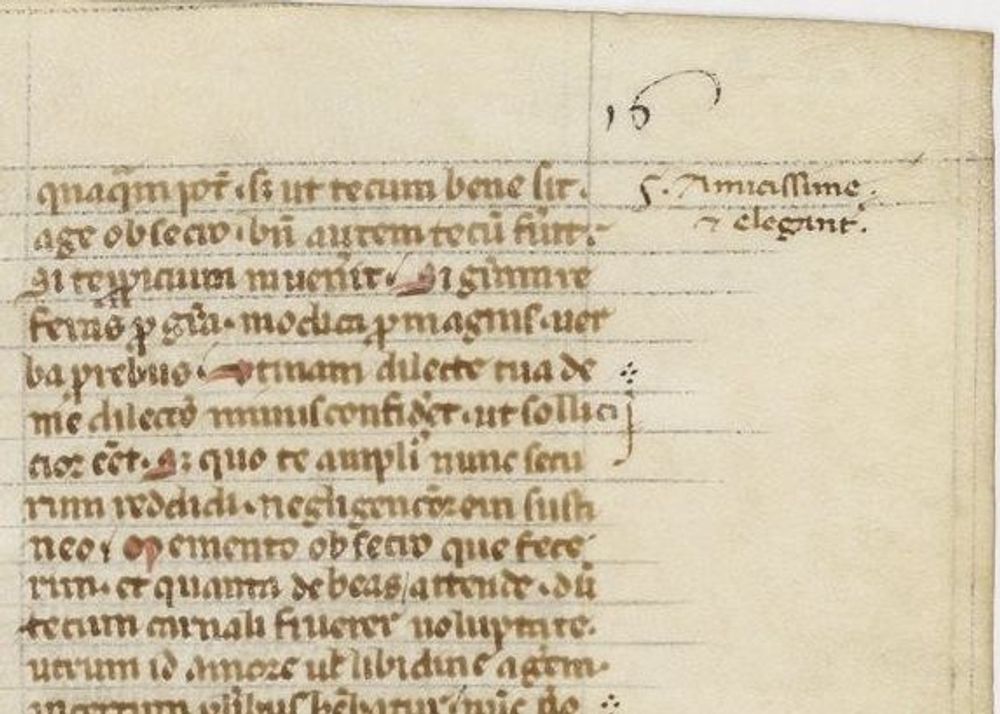
https://gallica.bnf.fr/ark:/12148/btv1b84386206
Petrarch’s remarks on Abelard’s and Heloise’s style of writing sometimes take the shape of a dialogue, as if he were engaging in conversation with them. On f. 22v, in the margin of Abelard’s reply to Heloise (letter V), he addresses Abelard directly: “Non ineleganter ais, petre”; “You have said this quite elegantly, Peter.”
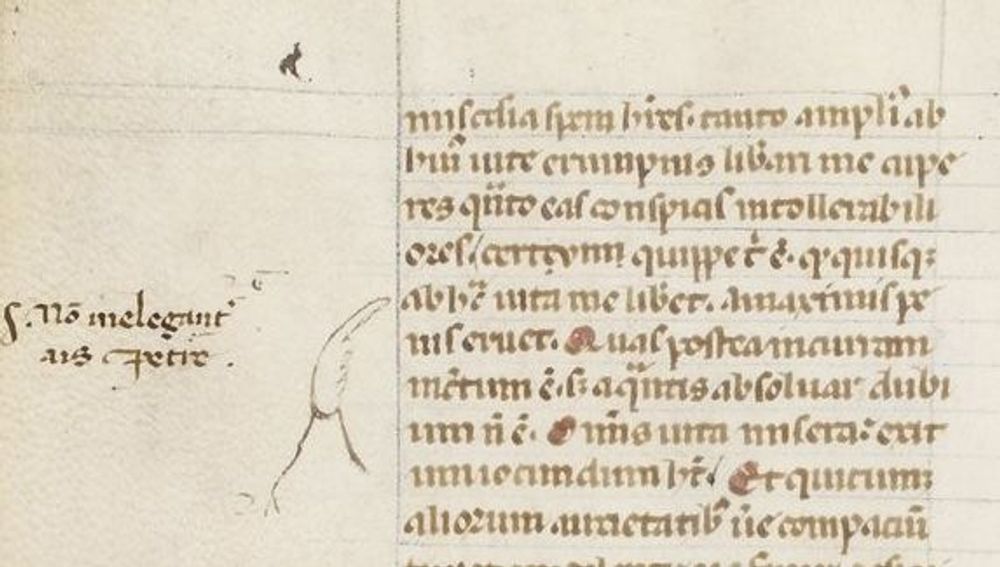
https://gallica.bnf.fr/ark:/12148/btv1b84386206
Not every word or action of Abelard met with Petrarch’s approval. He criticized Abelard, for example, for dragging Heloise down with him. Next to a passage where Heloise wrote that it was not devotion that brought her to the monastery, but “an unfortunate love and a cruel relation”, Petrarch wrote: “… quo post te demum vel invita traheretur Heloysa tua, Petre”; “… in the end your Heloise was hauled here after you against her will, Peter”.

https://gallica.bnf.fr/ark:/12148/btv1b84386206
Heloise, by contrast, received nothing but praise. Petrarch expressed his admiration for her, as if she were standing right before him: “Valde perdulciter ac blande per totum agis, Heloysa”; “Truly you act most sweetly and persuasively in everything, Heloise”. The remark is accompanied by a pointing hand and his characteristic attention sign in the shape of a flower. It is evident that Petrarch’s regard for Heloise went beyond a mere appreciation of her rhetorical style and extended to her demeanor and stance in life.
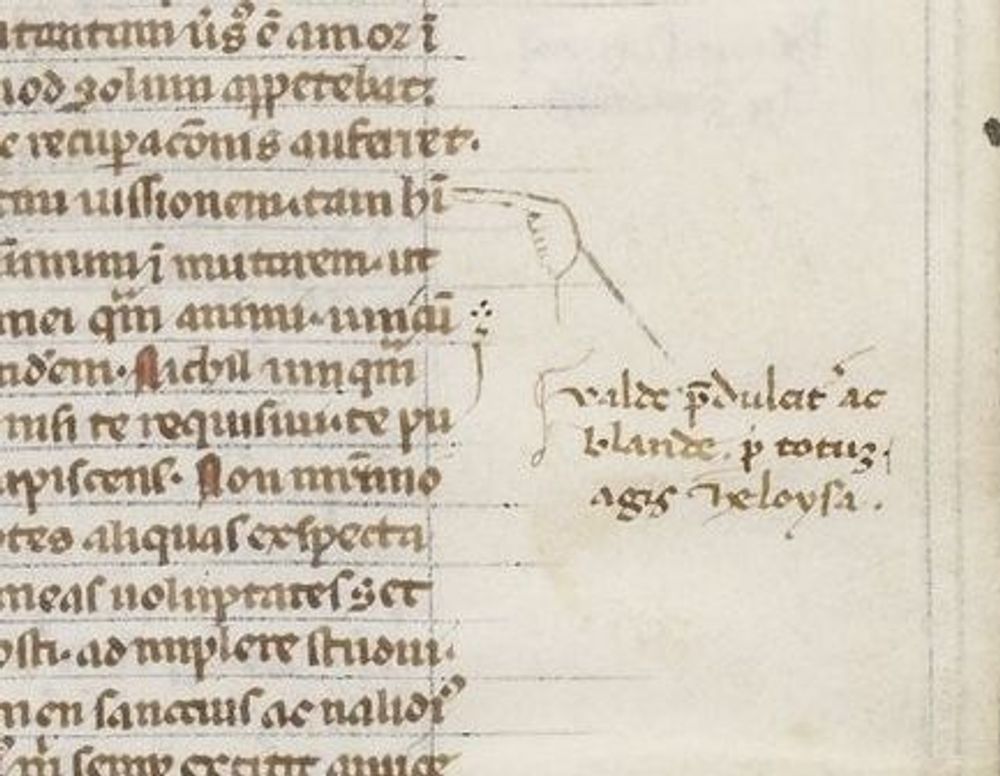
https://gallica.bnf.fr/ark:/12148/btv1b84386206
Was it Petrarch, who rubbed away Heloise’s face from the opening initial of this codex? If so, his touching of Heloise’s face will not have been a gesture of rejection, but rather of admiration.
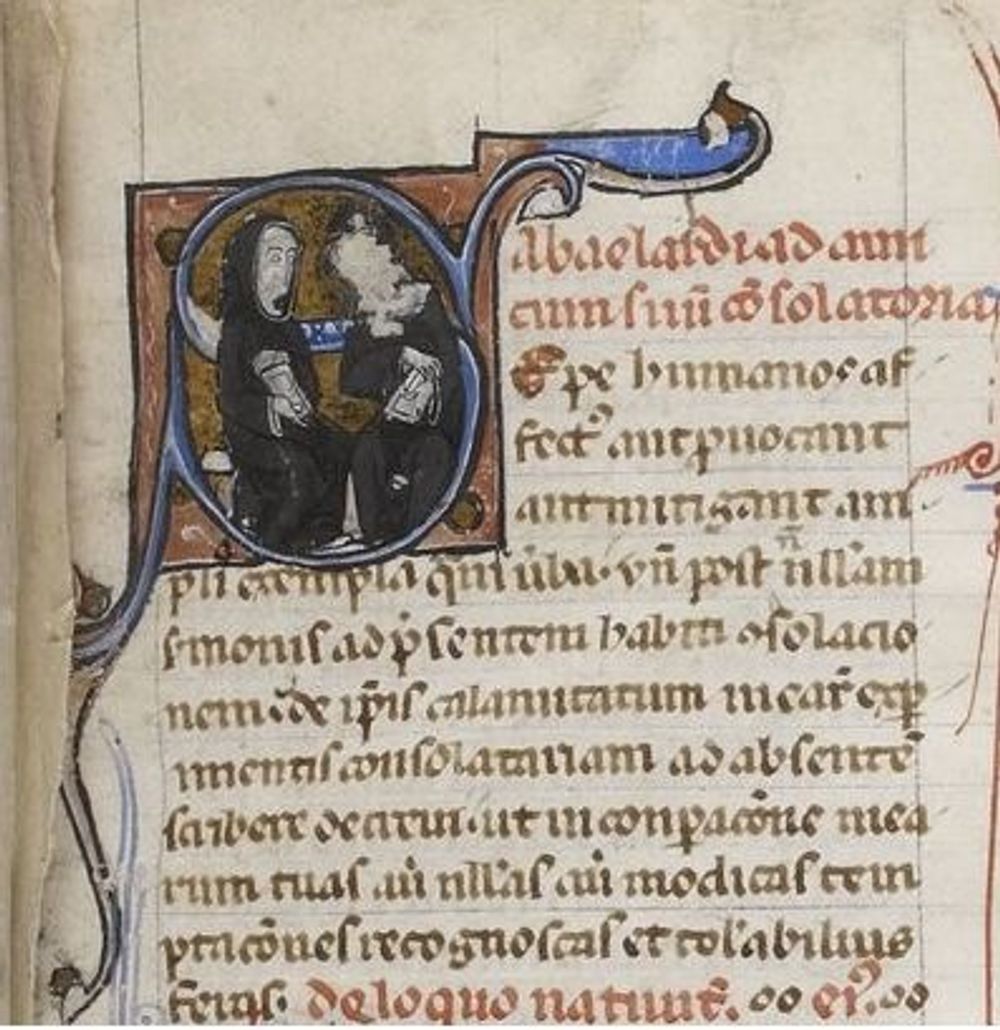
https://gallica.bnf.fr/ark:/12148/btv1b84386206
In 1362 Petrarch donated many of his manuscripts to the Republic of Venice, but apparently kept Paris, BnF, lat. 2923 in his possession. This may be taken as evidence that Petrarch was not only interested in classical texts, as is often held, but also in medieval epistolary compositions, providing him with examples of admirable rhetorical style.
After his death in 1374, the remaining manuscripts were dispersed throughout Europe. Manuscript Paris, BnF, lat. 2923 found its way to the library of the dukes of Milan, where it is mentioned in a catalogue of 1426. After 1501 it ended up in the Bibliothèque royale de Blois, the library of Louis XII (r. 1498-1515). On one of the flyleafs, f. IIr, is a shelfmark of that library: ‘tab 7 xiiii’.
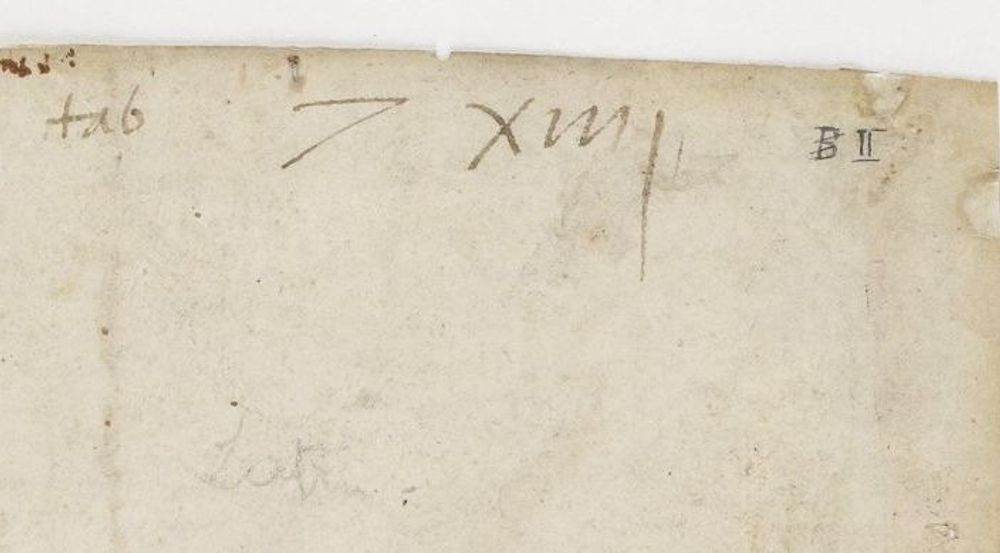
https://gallica.bnf.fr/ark:/12148/btv1b84386206
Petrarch used the flyleaves at the end of the codex to keep tabs on his struggles with sexual temptation. He used a code of dots, dashes and crosses to mark specific nights and days between the years 1344 and 1349.6 The code has not been deciphered yet, but exclamations such as ‘heu heu’ (encircled in red) suggest that Petrarch’s fight against temptations was not entirely successful.
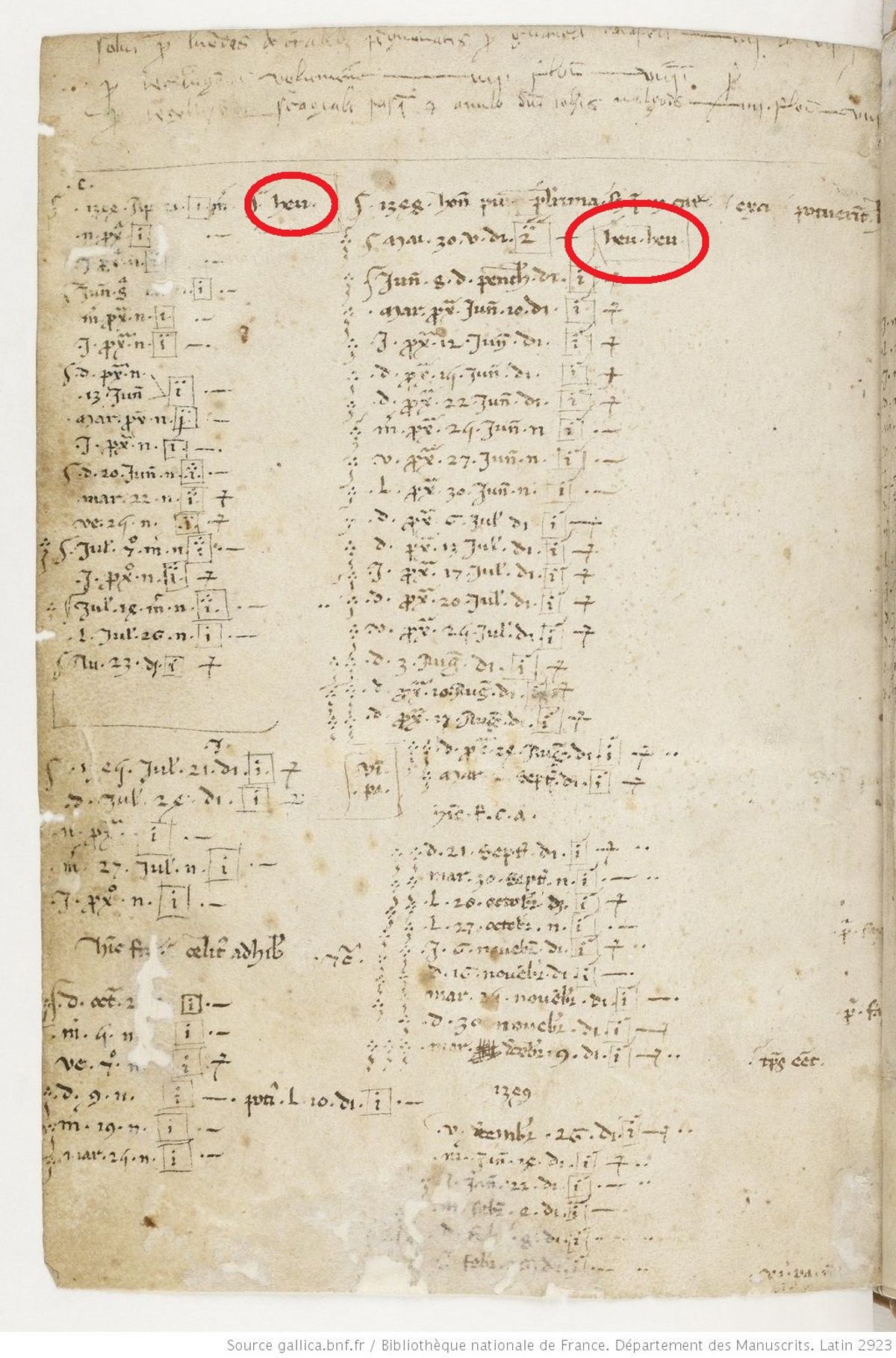

Sources used for this contribution:
- Leclerq, Jean, 'l'amitié dans les letters au Moyen age', Revue du Moyen Age Latin 1 (1945), pp. 391–410
- Luscombe, David (ed.), The Letter Collection of Abelard and Heloise, translated by Betty Radice and revised by David Luscombe (Oxford, Oxford University Press, 2013)
- Mews, Constant J., ‘Interpreting Abelard and Heloise in the fourteenth and early fifteenth centuries. The criticisms of Christine de Pizan and Jean Gerson’, in P. J. J. M. Bakker, E. Faye, & C. Grellard (eds.), Chemins de la pensee medievale. Etudes offertes a Zenon Kaluza (Turnhout, Brepols, 2002), pp. 709 – 724
- Jakubecki, Natalia G., ‘Petrarca lector de Abelardo. Transcripción y estudio hermenéutico de las notas marginales al epistolario’, Revista española de filosofia medieval 22 (2015), p. 147-169
Contribution by Irene van Renswoude. I thank Janneke Raaijmakers for her critical reading and always excellent suggestions for my contributions.
Cite as, Irene van Renswoude, “Paris, BnF, lat. 2923”, The art of reasoning in medieval manuscripts (Dec 2020), https://art-of-reasoning.huygens.knaw.nl/lat2923. ↑
For the date, see Mews, ‘Interpreting Abelard and Heloise, p. 716. ↑
Leclerq, L’amitié, p. 393. ↑
Leclerq, L’amitié, p. 396. ↑
Jakubecki, ‘Petrarca lector de Abelardo’ p. 153. ↑
Mews, ‘Interpreting Abelard and Heloise’, 717 ↑


